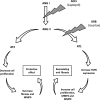Bicuspid aortic valve aortopathy: genetics, pathophysiology and medical therapy
- PMID: 23728086
- PMCID: PMC3745132
- DOI: 10.1093/icvts/ivt196
Bicuspid aortic valve aortopathy: genetics, pathophysiology and medical therapy
Abstract
The association between ascending aortic aneurysm (AA) and bicuspid aortic valve (BAV) has been well established. Different genetic, haemodynamic and cardiovascular risk factors have been implicated in the development and progression of AA. However, to date, definite conclusions cannot be drawn regarding the exact molecular, cellular and haemodynamic mechanisms causing BAV-associated aortopathy. For this study, we performed a thorough electronic systematic review of the literature using MEDLINE (1960-2012) and EMBASE databases. MeSH terms included: 'bicuspid aortic valve and ascending aorta', 'bicommissural aortic valve and aneurysm', 'bicuspid aortopathy', 'bicuspid aortic valve pathophysiology', 'bicuspid aortic valve and genetics' and 'bicuspid aortic valve and treatment'. We aim in this review to discuss the mechanisms, pathophysiology, genetics and modern drug therapy in the context of BAV-associated aortopathy.
Keywords: Aortic aneurysm; Aortopathy; Bicuspid aortic valve; Genetics; Medical therapy.
Figures



Similar articles
-
Surgical thresholds for bicuspid aortic valve associated aortopathy.JACC Cardiovasc Imaging. 2013 Dec;6(12):1311-20. doi: 10.1016/j.jcmg.2013.10.005. JACC Cardiovasc Imaging. 2013. PMID: 24332283
-
Bicuspid aortic valve and associated aortopathy: an update.Semin Thorac Cardiovasc Surg. 2013 Winter;25(4):310-6. doi: 10.1053/j.semtcvs.2014.01.004. Epub 2014 Jan 24. Semin Thorac Cardiovasc Surg. 2013. PMID: 24673960 Review.
-
Surgical threshold for bicuspid aortic valve aneurysm: a case for individual decision-making.Heart. 2015 Sep;101(17):1361-7. doi: 10.1136/heartjnl-2014-306601. Epub 2015 Jun 15. Heart. 2015. PMID: 26076937 Review.
-
The role of hemodynamics in bicuspid aortopathy: a histopathologic study.Cardiovasc Pathol. 2019 Jul-Aug;41:29-37. doi: 10.1016/j.carpath.2019.03.002. Epub 2019 Apr 1. Cardiovasc Pathol. 2019. PMID: 31029755
-
Magnetic resonance imaging-based hemodynamic wall shear stress alters aortic wall tissue biomechanics in bicuspid aortic valve patients.J Thorac Cardiovasc Surg. 2024 Aug;168(2):465-476.e5. doi: 10.1016/j.jtcvs.2022.12.021. Epub 2023 Jan 13. J Thorac Cardiovasc Surg. 2024. PMID: 36797175 Free PMC article.
Cited by
-
Cardiac Embryology and Molecular Mechanisms of Congenital Heart Disease: A Primer for Anesthesiologists.Anesth Analg. 2016 Sep;123(3):551-69. doi: 10.1213/ANE.0000000000001451. Anesth Analg. 2016. PMID: 27541719 Free PMC article. Review.
-
Evaluation of relationship between bicuspid aortic valve phenotype with valve dysfunction and associated aortopathy.J Cardiovasc Thorac Res. 2018;10(4):236-242. doi: 10.15171/jcvtr.2018.41. Epub 2018 Dec 13. J Cardiovasc Thorac Res. 2018. PMID: 30680084 Free PMC article.
-
Aneurysm-Specific miR-221 and miR-146a Participates in Human Thoracic and Abdominal Aortic Aneurysms.Int J Mol Sci. 2017 Apr 20;18(4):875. doi: 10.3390/ijms18040875. Int J Mol Sci. 2017. PMID: 28425970 Free PMC article.
-
Point on the Aortic Bicuspid Valve.Life (Basel). 2022 Mar 31;12(4):518. doi: 10.3390/life12040518. Life (Basel). 2022. PMID: 35455009 Free PMC article. Review.
-
Medial tunica degeneration of the ascending aortic wall is associated with specific microRNA changes in bicuspid aortic valve disease.Mol Med Rep. 2021 Dec;24(6):876. doi: 10.3892/mmr.2021.12516. Epub 2021 Nov 2. Mol Med Rep. 2021. PMID: 34726256 Free PMC article.
References
-
- Hoffman JIE, Kaplan S. The incidence of congenital heart disease. J Am Coll Cardiol. 2002;39:1890–900. doi:10.1016/S0735-1097(02)01886-7. - DOI - PubMed
-
- Michelena HI, Khanna AD, Mahoney D, Margaryan E, Topilsky Y, Suri RM, et al. Incidence of aortic complications in patients with bicuspid aortic valves. JAMA. 2011;306:1104–12. doi:10.1001/jama.2011.1286. - DOI - PubMed
-
- Huntington K, Hunter MD, Alasdair GW, Chan MD. A prospective study to assess the frequency of familial clustering of congenital bicuspid aortic valve. J Am Coll Cardiol. 1997;30:1809–12. doi:10.1016/S0735-1097(97)00372-0. - DOI - PubMed
-
- Fedak PWM, Verma S, David TE, Leask RL, Weisel RD, Butany J. Clinical and pathophysiological implications of a bicuspid aortic valve. Circulation. 2002;106:900–4. doi:10.1161/01.CIR.0000027905.26586.E8. - DOI - PubMed
-
- Kerstjens-Frederikse WS, Du Marchie Sarvaas GJ, Ruiter JS, Van Den Akker PC, Temmerman AM, Van Melle JP, et al. Left ventricular outflow tract obstructions: should cardiac screening be offered to first-degree relatives? Heart. 2011;97:1228–32. doi:10.1136/hrt.2010.211433. - DOI - PubMed
Publication types
MeSH terms
LinkOut - more resources
Full Text Sources
Other Literature Sources
Medical

